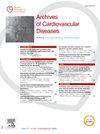Potential additive prognostic value of late gadolinium enhancement to the risk prediction score for life-threatening ventricular tachyarrhythmias in laminopathy: Results from a multicentric retrospective study
IF 2.3
3区 医学
Q2 CARDIAC & CARDIOVASCULAR SYSTEMS
引用次数: 0
Abstract
Background
Cardiac laminopathy is associated with a high burden of life-threatening ventricular tachyarrhythmias (LTVTA). A LMNA-LTVTA risk calculator was previously validated and implantable cardioverter defibrillator is recommended in patients with a 5 years calculated risk ≥ 10%, but additional prognostic markers in patients with lower risk are missing.
Objectives
To study the potential additive value of late gadolinium enhancement (LGE) on cardiac magnetic resonance (CMR) for LTVTA risk stratification in laminopathy.
Methods
LMNA pathogenic variant carriers with CMR data available including patients with cardiac laminopathy and asymptomatic relatives were included in a retrospective multicentric study. LGE phenotype was compared to cardiac laminopathy characteristics. The additive prognostic value of LGE presence on the risk of occurrence of the composite endpoint of cardiovascular death and LTVTA was studied (Figure 1, Figure 3).
Results
121 patients were included (mean age 38 ± 16, 47% males), among which 81 (67%) had a cardiac laminopathy phenotype. 51 (42%) exhibited LGE. Patients with LGE had more atrio-ventricular blocks and more reduced left ventricular ejection fraction at the time of CMR than patients without (53% vs 38% P = 0.03; 49 ± 14% vs 60 ± 10% P < 0.0001 respectively). 61% of patients with LGE had a calculated LMNA-LTVTA risk ≥ 10% versus 25% without (P = 0.0003), but LTVTA history was not more frequent in LGE patients (8% vs 11% in patients without, P = 0.5) (Fig. 2). During a median follow-up of 4 years (range 1–25), 38 patients (31%) experienced LTVTA (n = 29, 24%) or cardiovascular death (n = 9, 7%). On multivariate analysis, LGE presence did not provide additional prognostic value to LMNA-LTVTA calculated risk. There was no significant interaction between LGE presence and occurrence of LTVTA or cardiovascular death within the different LMNA-LTVTA calculated risk categories (P = 0.9).
Conclusion
LGE did not provide additional prognostic value to the LMNA-LTVTA risk calculator for LTVTA or cardiovascular death risk prediction.
晚期钆增强对椎板病危及生命的室性心动过速风险预测评分的潜在附加预后价值:来自一项多中心回顾性研究的结果
背景:心脏板层病与危及生命的室性心动过速(LTVTA)的高负担相关。LMNA-LTVTA风险计算器先前已被验证,并且在5年计算风险≥10%的患者中推荐植入式心律转复除颤器,但在风险较低的患者中缺少其他预后标志物。目的探讨心脏磁共振(CMR)晚期钆增强(LGE)对椎板病LTVTA危险分层的潜在附加价值。方法采用回顾性多中心研究方法,对具有CMR数据的slmrna致病变异携带者,包括心脏板层病患者和无症状亲属。将LGE表型与心肌板层病特征进行比较。研究LGE存在对心血管死亡和LTVTA复合终点发生风险的加性预后价值(图1、图3)。结果121例患者(平均年龄38±16岁,男性占47%),其中81例(67%)有心肌板层病表型。51例(42%)出现LGE。在CMR时,LGE患者比无LGE患者有更多的房室传导阻滞和更多的左室射血分数降低(53% vs 38% P = 0.03;49±14% vs 60±10% P <;0.0001分别)。61%的LGE患者的LMNA-LTVTA风险≥10%,而非LGE患者的LMNA-LTVTA风险为25% (P = 0.0003),但LGE患者的LTVTA病史并不更常见(8% vs 11%, P = 0.5)(图2)。在中位随访4年(1-25年)期间,38名患者(31%)出现LTVTA (n = 29.24%)或心血管死亡(n = 9.7%)。在多变量分析中,LGE的存在并没有为LMNA-LTVTA计算的风险提供额外的预后价值。在不同的LMNA-LTVTA计算风险类别中,LGE的存在与LTVTA的发生或心血管死亡之间没有显著的相互作用(P = 0.9)。结论lge对LMNA-LTVTA风险计算器在LTVTA或心血管死亡风险预测方面没有提供额外的预后价值。
本文章由计算机程序翻译,如有差异,请以英文原文为准。
求助全文
约1分钟内获得全文
求助全文
来源期刊

Archives of Cardiovascular Diseases
医学-心血管系统
CiteScore
4.40
自引率
6.70%
发文量
87
审稿时长
34 days
期刊介绍:
The Journal publishes original peer-reviewed clinical and research articles, epidemiological studies, new methodological clinical approaches, review articles and editorials. Topics covered include coronary artery and valve diseases, interventional and pediatric cardiology, cardiovascular surgery, cardiomyopathy and heart failure, arrhythmias and stimulation, cardiovascular imaging, vascular medicine and hypertension, epidemiology and risk factors, and large multicenter studies. Archives of Cardiovascular Diseases also publishes abstracts of papers presented at the annual sessions of the Journées Européennes de la Société Française de Cardiologie and the guidelines edited by the French Society of Cardiology.
 求助内容:
求助内容: 应助结果提醒方式:
应助结果提醒方式:


